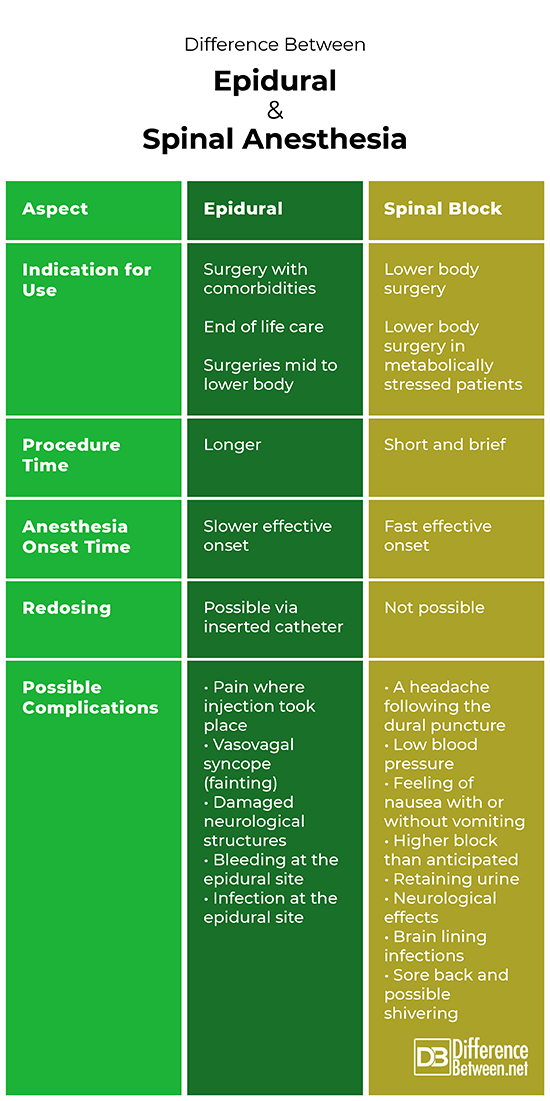Difference Between Epidural and Spinal Anesthesia

Introduction
In anatomy, both the brain and spinal cord are covered in several layers of membranes which are collectively referred to as the meninges. There are three layers of meninges which include the dura mater, arachnoid mater and the pia mater. The spaces between and within the meninges can be used to perform regional anesthesia, a suitable and great alternative to general anesthesia.
Epidural and spinal anesthesia (or spinal block) have similarities but also have unique differences. A certain anesthetic treatment may be more suitable to a particular condition or treatment plan determined by medical professionals.

This article uncovers a few of the major differences between epidural and spinal anestheisa.
Definition of Epidural and Spinal Anesthesia
Epidural anesthesia is a technique typically used for pain management. It is useful as a type of primary anesthetic, but it is more commonly used as a treatment mechanism in pain management. Epidural aesthesia can be given in a single shot or as a continuous infusion (with a connected drip) for longer terms of pain relief. This procedure time takes slightly longer and the effects take longer.
When performing this type of treatment, medication is injected into the epidural space (the specific space outside of the dura mater). A type of catheter can then be placed into the space to provide a route for redosing purposes.
Spinal anesthesia is done by injection into the arachnoid mater. As previously mentioned, the arachnoid mater is the middle layer of the spinal cord which is filled with fluid cushioning the brain and spinal cord. Depending on the type of drug that is required as well as the position of the patient, a targeted level of the block (basically, a level from where the anesthesia is effective) can be achieved. This procedure time is slightly shorter than in epidural procedures and effects are faster/
Interestingly, spinal and epidural anesthesia can be used together!
Indication for Use
Epidural is often used to supplement a full (also known as “general”) anesthesia. This is relevant in surgical procedures where a patient may have comorbidities. This form of anesthesia is also used post-surgery and in end-of-life treatments. It can also be used for surgeries from the middle of the body towards the the lower extremities.
Spinal anesthesia is a safe and effective alternative to general anesthesia when the surgical site is located on the lower extremities or a part of the lower body. A good example is in Caesarean birth deliveries. These are done under spinal anesthesia regularly. When a patient is sensitive to the metabolic stress that would come as a response to surgery then spinal anesthesia is used.
Contraindications for Use
For both anesthesia, use is contraindicated when patients have high intercranial pressure, when patients do not want it, when there is a low blood volume, infection, a history of surgery on the back and when there is severe disfunctions of the aorta.
Possible Complications
For epidural anesthesia, possible complications include:
- Pain where injection took place
- Vasovagal syncope (fainting)
- Damaged neurological structures
- Bleeding at the epidural site
- Infection at the epidural site
In spinal anesthesia, possible complications can potentially be:
- A headache following the dural puncture
- Low blood pressure
- Feeling of nausea with or without vomiting
- Higher block than anticipated
- Retaining urine
- Neurological effects
- Brain lining infections
- Sore back and possible shivering
Table of comparison between epidural and spinal anesthesia

Summary
In many aspects spinal and epidural anesthesia are very similar. The procedures are similarly physically done and the contraindications for administration of the types of anesthesia are also similar.
There major differences between the two are mostly in the duration of action and the indications which also differ. Epidurals take longer to kick in and they last much longer. Spinal anesthesia takes effect more rapidly but cannot be redosed for a long duration of effect. Epidurals are also an option for end-of-life care, where spinal anesthesia (or spinal block) is only used for surgical procedures.
It is important to make an informed decision with your anesthetist regarding the best anesthetic for your surgical procedure or options regarding analgesia
FAQ
What is the difference between epidural and spinal Anesthesia?
The difference is outlined above, but in summary, the difference lies in the space where the medication is injected within the meninges. Spinal anesthesia is commonly used for caesarean sections or surgery to the lower limbs, where epidural anesthesia can also be used with other forms of anesthesia, or as main anesthesia for procedures below the middle of the body.
What hurts more epidural or spinal block?
Research shows that the perceived pain (actual pain felt) is higher for spinals, however perceived pain was lower than predicted (or expected) pain for both spinals and epidurals.
What is a saddle block vs epidural?
Saddle block is a spinal anesthetic that is restricted only to the perineal area, or that part of the body that would be in touch with a saddle. It is done by using a small dose of local anaesthetic and the patient is kept in a seated position after the injection procedure. It has a major advantage in avoiding a drop in blood pressure.
Are Extradural and epidural the same?
The difference between extradural and epidural is that extradural means it is outside of the dura mater while epidural is done on or outside the dura mater.
- Difference Between a Cochlear Implant and Normal Hearing - October 4, 2022
- Difference Between Obstructive and Restrictive Spirometry - September 11, 2022
- The Difference Between White Box and Black Box Testing - September 11, 2022
Search DifferenceBetween.net :
Leave a Response
References :
[0]Hernandez, Aliva. & Singh, Paramvir. “Epidural Anesthesia”. https://www.ncbi.nlm.nih.gov/books/NBK542219/
[1]Toledano, Roulhac. D. & Van de Velde, Marc. “Epidural Anesthesia and Analgesia” https://www.nysora.com/topics/regional-anesthesia-for-specific-surgical-procedures/abdomen/epidural-anesthesia-analgesia/
[2]Yano, T,m Iwasaki, T., Naruo, H. & Tsuneyoshi, I. “Comparison of predicted and perceived pain from epidural and spinal puncture in patients undergoing elective caesarean section”. Anesthetic Intensive Care, vol. 34, no. 4, 2011, pp: 646-649.
